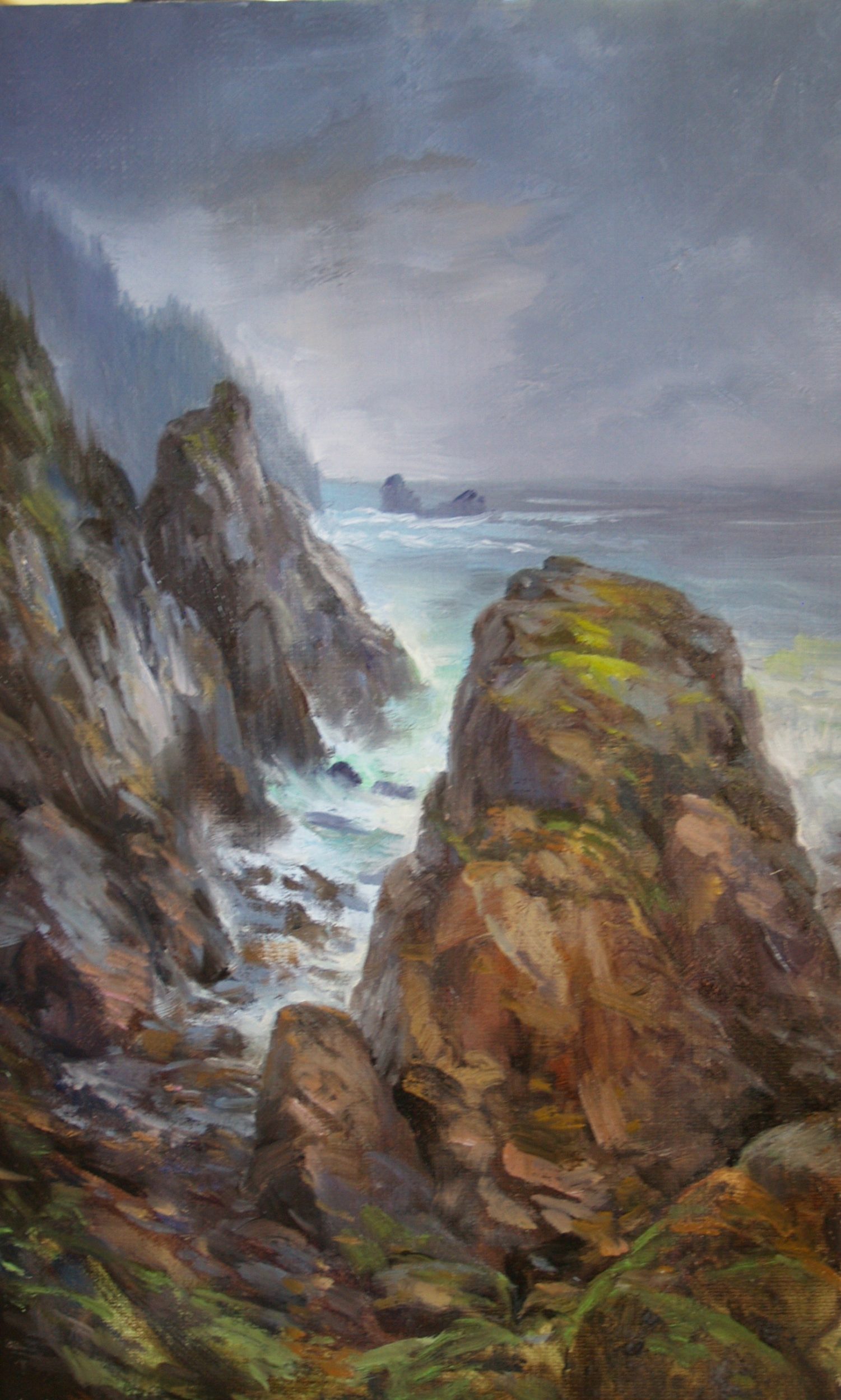“Whaler’s Cove” ~ 12×8 Oil Painting
April 13 2015
Point Lobos
After exploring the Monterey coast waiting for the sun to rise and the fog to lift, I discovered a hidden bay at the entrance of Point Lobos called Whaler’s Cove where I noticed the subtle effects of aerial perspective and receding values that would create a beautiful painting. This quiet bay was undulating with sea kelp which was quite a contrast to the dramatic sea pounding with waves on the coast that we saw earlier this morning. My colleague Kris Baxter and I climbed up the embankment and set up our easels for a morning of plein air painting.
Painting in the fog offers an interesting study in values. In this little painting of “Whaler’s Cove,” I found that the overcast sky provided a neutral background that simplified the details of the masses as the landscape fell away from us. The teal blue water breaking along the beach below complemented the grey palette of the painting, offering an illuminated focal point for the painting. The values lightened and got colder as the scene regressed into the fog creating the feeling of depth or aerial perspective. The foreground was darker and warmer which brought the cliffs closer to the viewer.
Personally, I like painting a marine painting at low tide when the rocks are exposed and there is less water so that I can play with the rock shapes and colors. Also, the early morning light shows more of the rock structures allowing me to exaggerate edges and make a strong design with planes of interesting color.
In most cases, the sky will illuminate your painting and will be the lightest plane in your picture. I find that having the sky as the light source will create a very low contrast painting that can be boring to look at, and understanding this can often save a painting from disaster. Instead, I called attention to the beautiful color in the water scarf and combined it with the light to create the effect of glared light on the scarf that becomes the lightest part of the composition.
Transitions are often overlooked in a painting and many artists will finish with a flat painting without transitions. I often tell my students that every inch of your painting should be in transition ~ either from dark to light value, or cool color temperature to warm. In this study, notice that the sky has transitions from dark on the left to a lighter value on the right, and likewise from top to bottom. The water also transitions from dark in the back to light in the front. This transition or gradation establishes depth.
When painting from nature, I establish the brightest spot first and then judge all the other values in the painting by it. The effect in “Whaler’s Cove” would have been lost if I made either the sky or the foreground too light. The dark silhouette of the foreground rocks are painted against the distant mass of the water giving the composition a sense of strength and balance, and the contrast in their value helps push the background slopes of the cliffs further back creating depth.
_________________________________________________
Plein air and alla prima artist Stefan Baumann, host of the PBS painting series “The Grand View, America’s National Park through the eyes of an artist” and author of “Observations Of Art and Nature,” travels in his vintage travel trailer painting America’s western landscape. Baumann paints outdoors with oils and canvas capturing stunning vistas, wildlife, western landscapes, National Parks and still life, thrilling art collectors throughout the world. He has many international collectors acquiring his paintings as investments. His painting style is called Romantic Realism with Luminism, and the extraordinary way he captures the effect of light is a truly American style used to paint the Western landscape. He can be seen plein air painting in Yellowstone, Yosemite and in the Grand Canyon. Baumann’s “how to paint” DVDs filmed on location in the National Parks are the very best on the market.

